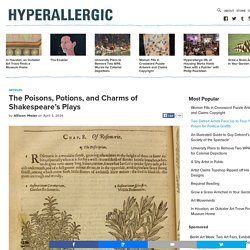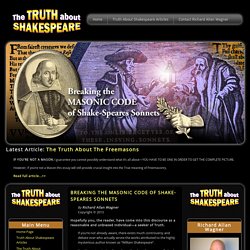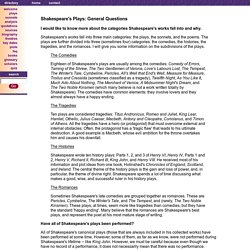

Poem of the week: The Phoenix and the Turtle by William Shakespeare. This week's poem, William Shakespeare's "The Phoenix and the Turtle", was first published in 1601, in an anthology entitled Love's Martyr.

The collection begins with a long poem by Robert Chester, and includes work by various hands, including Ben Jonson and George Chapman, all of it having a "phoenix and turtle" theme. The volume is thought to have been designed as both a lament for the coming extinction of the Tudor monarchy, and a celebration of the Jacobean succession. The phoenix, that splendid mythological bird which is self-consumed by fire every 500 years and regenerates itself from its own ashes, was a symbol associated with the Virgin Queen. Shakespeare's allegorical subtext has long kept the scholars asking questions. The Poisons, Potions, and Charms of Shakespeare’s Plays. John Gerard, Robert Davies, Thomas Johnson, Robert Priest, John Payne, and Rembert Dodoens, ‘The herball or Generall historie of plantes’ (London, 1633), printed by Adam Islip Joice Norton and Richard Whitakers (courtesy Currier Museum of Art Library and Archives) Potions, poisons, and symbolic herbs are frequent plot devices in the plays of William Shakespeare, and reflect the medical knowledge of his time.

Herbals recorded the plant-based concoctions, and through these rare books we can connect his references to remedies of the 16th and 17th century, whether the potent sleeping draught consumed by Juliet, or the rosemary “for remembrance” perfuming Ophelia’s bouquet. Engraving by W. Byrne after Edward Edwards of the three witches of Macbeth concocting a potion in their cauldron (1773) (via Wellcome Images/Wikimedia) (click to enlarge) Petersen saw potions as an accessible introduction to both a deeper meaning in the plays and the history of herbals.
William Shakespeare and Freemasonry. Sir Francis Bacon, who was William Tudor, who was William Shakespeare. The Truth About Shakespeare. Breaking the Masonic Code of SHAKE-SPEARES SONNETS. Breaking the Masonic Code of SHAKE-SPEARES SONNETS By Richard Allan WagnerCopyright © 2013 Hopefully you, the reader, have come into this discourse as a reasonable and unbiased individual—a seeker of Truth.

If you’re not already aware, there exists much controversy and debate over who actually wrote the works attributed to the highly mysterious author known as “William Shakespeare”. Yes, the vast majority of people on the planet have generally (and unknowingly) accepted the premise that a man named “William Shakespeare” (of Stratford) wrote the literary works attributed to him. The problem rests with the fact that there is scarce evidence of the Stratford man’s existence—but more importantly, there is NO TANGIBLE EVIDENCE the “Stratford man” wrote the literary body of work for which he is given credit—in fact, there is a mountain of hard, legitimate evidence to the contrary!
The LOST SECRET of William Shakespeare (www.TheLostSecretofWilliamShakespeare.com) Johnson states: “Mr. Breaking the Masonic Code of SHAKE-SPEARES SONNETS. Breaking the Masonic Code of SHAKE-SPEARES SONNETS. Plot Summaries. Open Source Shakespeare: search Shakespeare's works, read the texts.
Shakespeare's Plays: Common Questions about Shakespeare's Plays. Shakespeare's Plays: General Questions I would like to know more about the categories Shakespeare's works fall into and why.

How many poems, plays, and sonnets did shakespeare write altogether? Shakespeare: plays by category. You can also search the plays for occurrences of specific words.

Or you can view lists of them in alphabetical order or in rough chronological order. Shakespeare's plays are often arranged in three categories: tragedy, comedy, or history. The arrangement here is based on the arrangement of The Riverside edition, but it is important to realize that the categories are not Shakespeare's. A number of Shakespeare's plays were published as quarto editions (so-named because the paper was folded twice, make four pages on one side of a sheet of paper) during his lifetime. These individual editions had no "category" listed, though they often contained words like history or tragedy in the title, e.g.
Complete list of Shakespeare's plays, by genre : See a list of all the characters(warning: takes several seconds to load) Plays Sonnets Poems Concordance Character Search Advanced Search About OSS.
